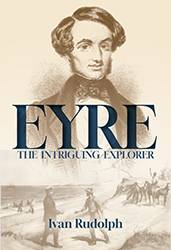Baxter’s Bones
William Graham, who had a good working knowledge of Eyre’s journey, was Station Master at Eyre Sand Patch in 1878. The deposit of water there that had saved Eyre and party had since become the site of a repeater station on the famous Overland Telegraph Line, whose surveyors had referred often to Eyre’s chart and journals and the line followed almost exactly his route. Other repeater stations were at the water deposits Eyre had discovered 36 years previously.
Graham wrote: “The natives last week [January 1882] brought Baxter’s legs, arms and other bones to our linesman, Mr John Healy, when on the line fifty miles west; also portion of the ironwork, saddle and horseshoe nails in a wonderful state of preservation, fit for use again. I some time ago recovered a gun, the barrels and nipples eaten out with rust and the metal of the barrels eaten through in the thin parts of the muzzle, but the platinum air tubes and gold inlaid work were perfect.”
He organised John Healy to put together a search party to find the rest of Baxter’s remains. They knew the fatal campsite had been approximately 44 miles west of Eyre Sand Patch and eventually found it, scraping up further relics such as buckles, spurs, nails and leather fragments. In addition, more of Baxter’s bones were found scattered over 50 yards or so, probably by wild animals, but missing the skull.
The corroded barrels of a double-barrelled shotgun mentioned by Graham were found within a couple of miles of Eyre Sand Patch and not near the murder site. Five years later (1887) a gunlock was also found near where the barrels had been discovered. Graham assumed Neramberein and Cootachah had camped there on their way eastward again, and local Aborigines confirmed that they had done so. Perhaps they had run out of ammunition and abandoned the weapon as superfluous. However, there is no solid proof that this was the murder weapon. The gun may have been removed from one of Eyre’s earlier plants, for example the one between Eucla and Eyre Sand Patch contained rifles and has not been found officially, but may have been raided by wandering Aborigines. Otherwise some other traveller, such as a Policeman or Telegraph worker, may have lost the gun. Eyre has not left a sufficiently detailed description of the weapons stolen by Cootachah and Neramberein to make a positive identification.
Graham sent Baxter’s bones to Perth in 1882 in one strong calico bag and the relics in a second and third, all securely sewn shut by his wife. The gunlock was sent separately in 1887.
The bones ended up in the office of the Colonial Secretary of Western Australia.
On being told of the discovery, Eyre had written from England in 1883, “To me, it is a melancholy satisfaction to think that the bones of one who was so faithful to me, and who met a violent death in my service, are at last recovered and will now receive decent burial.”
A decent burial? He was not allowing for bureaucratic inefficiencies. Firstly, old bones cannot be buried quickly, can they? Months of letters must first go to and fro from different officials giving information and seeking permission – Perth, London, Downing Street. During this protracted time officials came and went.
When a search was conducted five years later, the bones and all the relics excepting for the gunlock had gone astray! There is no record that the bones were ever buried. There is no known gravesite or gravestone in Perth to commemorate Eyre’s brave old friend.
The gunlock survived and was exhibited at the Victoria Library in Perth for some years.
The Postmaster’s grandson, also named William Graham, became the driving force behind a successful re-enactment of Eyre’s journey between Fowlers Bay and Albany in 1991, being the 150-year anniversary of that epic trek.



